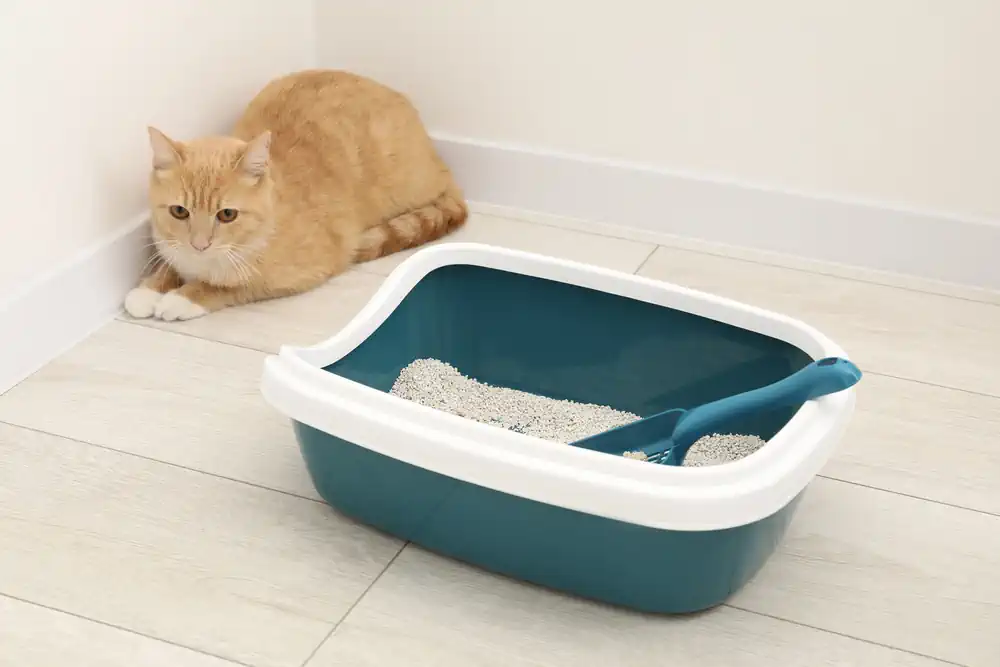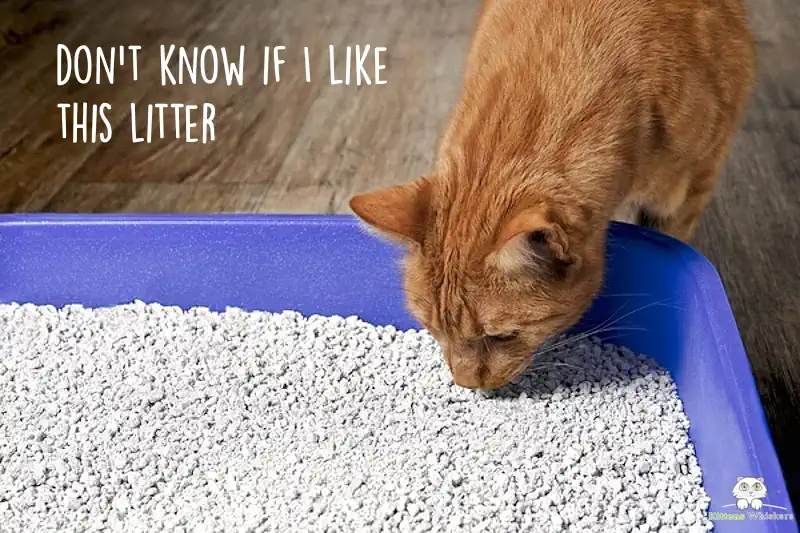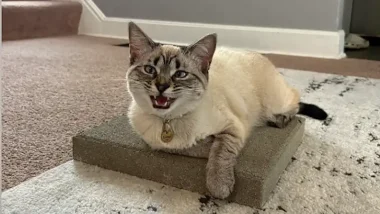I recently came across a story about a newly adopted cat who started off using her litter box perfectly for two weeks, and then suddenly stopped. Instead of the box, she began pooping in corners and sometimes peeing on pads. Her family has tried new litters, diapers, and even a sanctuary room, but the problem continues. They love her dearly and don’t want to give her up, but of course, they also don’t want their house to be ruined.

If you’ve ever had a cat with litter box issues, you know how stressful it can be. You scoop, you clean, you experiment – and still find “surprises” in places they don’t belong. I’ve been there, and I know many of you have too. The good news? There are reasons behind this behavior, and once you understand them, you can usually find a solution. Let’s talk about why cats avoid the litter box and what you can do to help.
Why Cats Sometimes Refuse the Litter Box
When a cat stops using the litter box, it’s seldom out of spite, even though it can feel that way when you’re scrubbing carpets at midnight. Instead, there are three main categories to think about: medical issues, litter box setup, and stress or behavioral factors. In my opinion, the very first step should always be to rule out medical causes.
Medical Causes You Should Rule Out First
Any sudden change in bathroom habits can be a red flag for underlying health issues. A vet visit is the first thing I’d suggest, not just to treat the cat, but also to give you peace of mind. Here are some common medical reasons cats stop using the box:
- Urinary tract infections (UTIs): These are painful and can make cats associate the box with discomfort. They might avoid it entirely. VCA Hospitals explains the symptoms and treatment.
- Kidney disease or diabetes: Both conditions increase urination, making it harder for cats to make it to the box. Cats Protection has more information on kidney problems in cats.
- Arthritis or joint pain: If climbing into a high-sided box hurts, cats may choose the floor instead. Arthritis is more common than many people realize in older cats. PetMD offers guidance on spotting the signs.
- Declawing complications: I’ve heard from multiple cat parents – and vets agree – that declawed cats sometimes avoid litter boxes because stepping on litter is physically painful. Read our articles explaining how declawing can lead to long-term discomfort.
- Anal gland issues: If these glands are full or infected, going to the bathroom can hurt. Cats may then look for softer or “different” surfaces.
- Parasites or digestive problems: Loose stools, constipation, or discomfort can make cats avoid the box.
The bottom line: before you change litters, buy new boxes, or stress yourself out, take your cat to the vet. You’ll either uncover a health issue that needs treatment, or you’ll be able to rule out medical causes and focus on behavioral solutions. I know it can feel easier to just try new products at home, but trust me, a vet visit can save you months of frustration.

Litter Box Setup Matters More Than You Think
Once medical causes are ruled out, the next step is to look at the litter box itself. I think this is one of the most overlooked areas, yet it’s often the key to solving the problem. Imagine if your bathroom was dirty, too small, or hard to get into – you’d want to avoid it, too. Cats are no different.
Here are a few things to consider:
- Size: Bigger is almost always better. Many people have had success with large storage totes or under-bed bins as litter boxes.
- Accessibility: Low-entry boxes can be life-changing for seniors or chonky cats who struggle to climb in.
- Number of boxes: The rule of thumb is one per cat, plus one extra. If you have one cat, that means two boxes minimum. Some cats even like to poop in one box and pee in another.
- Location: Keep boxes away from food and water, and in low-traffic, quiet areas where your cat feels safe.
- Covered vs uncovered: Some cats like privacy, others feel trapped by lids. You may have to experiment.
One cat parent shared that her cat refused to use a hooded litter box after years of no issues. She took the lid off, and the problem disappeared. Sometimes it’s that simple.
Finding the Right Litter
Litter preference is huge. Some cats will absolutely refuse a box if they dislike the texture or smell of what’s inside. I’ve seen this firsthand; one of my cats flat-out refused scented litter, no matter what brand it was. The moment I switched to unscented, the accidents stopped.

Here are a few directions to try:
- Unscented over scented: Cats have sensitive noses. What smells “fresh” to us can be overwhelming to them.
- Special attractants: Products like Dr. Elsey’s Cat Attract are designed to draw cats back to the box.
- Texture experiments: Soft sand-like litter, wood pellets, corn-based litter, or even mixing in soil for outdoor cats.
- Depth: Some cats prefer a shallow layer, others want a deeper bed. Try adjusting gradually.
I’ve heard many success stories where simply switching litter brands solved the issue. It’s worth some trial and error.
Cleanliness and Scent Control
Cats are famously clean creatures. If the box isn’t pristine, they may look elsewhere. One cat owner told me her boy would never use the box twice in a row; he expected it to be scooped after every use. Not everyone can keep up with that, so automatic litter boxes have become lifesavers for picky cats. They can be pricey, but so is replacing mattresses or carpeting.
Even more important is cleaning accident spots. Regular cleaners don’t always remove the odor molecules cats detect. Use enzymatic cleaners like Angry Orange or Bac-Out, and check with a blacklight to find hidden spots. There is also a DIY solution that I have used with great success. It’s inexpensive to make, and you probably already have the ingredients at home. If your cat smells an old mess, they may return to the same place again and again.
Stress and Behavioral Causes
Sometimes the issue isn’t physical at all; it’s emotional. Cats are sensitive, and changes in the home can throw them off. A new pet, a move, loud noises, even the scent of outdoor cats through a window, can create stress that shows up in the litter box.
I recently heard about a cat who kept peeing on the bed. The vet ruled out medical problems and said it was likely behavioral, often a mix of stress, territory, and routine disruption. For that cat, adding pheromone diffusers and limiting access to the bedroom helped. It’s a good reminder that sometimes “bad behavior” is really a cry for stability.

Here are some stress-related solutions you can try:
- Use pheromone diffusers like Feliway to create a calming environment.
- Give your cat safe spaces, cat trees, perches, or a quiet room they can retreat to.
- Stick to a routine: cats thrive on predictability.
- Reward box use with treats. Positive reinforcement can make a huge difference.
Training and Retraining
If nothing else seems to work, you may need to retrain your cat. That doesn’t mean punishment (which can make things worse), but gently teaching them where the right spot is. Some strategies include:
- Place a litter box where accidents are happening, then gradually move it to a better location.
- Confine your cat to a smaller space with their box until they’re using it consistently.
- Walk them to the box after meals and praise them when they use it.
- Consider working with a cat behaviorist for stubborn cases.
When Nothing Seems to Work
Sometimes, despite your best efforts, your cat may still struggle. I think it’s important to be honest about that. Some cats need long-term management, maybe always having pee pads down, or sticking with one very specific litter forever. Progress is still progress, even if it’s not perfect.
The key is patience. Cats aren’t being “bad”, they’re trying to communicate that something isn’t working for them. Your job is to figure out what that is.
Encouragement for Cat Parents
If your cat is struggling with litter box issues, you’re not alone, far from it. I’ve seen so many people go through the same thing, and while it’s frustrating, it doesn’t make you a bad cat parent. Just the fact that you’re reading this shows how much you care. ❤️
Be patient, keep experimenting, and remember that most cats do find their way back to the box with the right support. It may take time, but your love and consistency matter more than anything else.

Steps to Success
To recap, the path forward usually looks like this: start with a vet visit, adjust the litter box setup, experiment with litters, and then tackle stress and behavior. Along the way, keep things as clean and calm as possible.
I’d love to hear from you: Have you ever dealt with litter box struggles? What worked for you, and what didn’t? Your story might help another cat parent who’s feeling overwhelmed right now.

